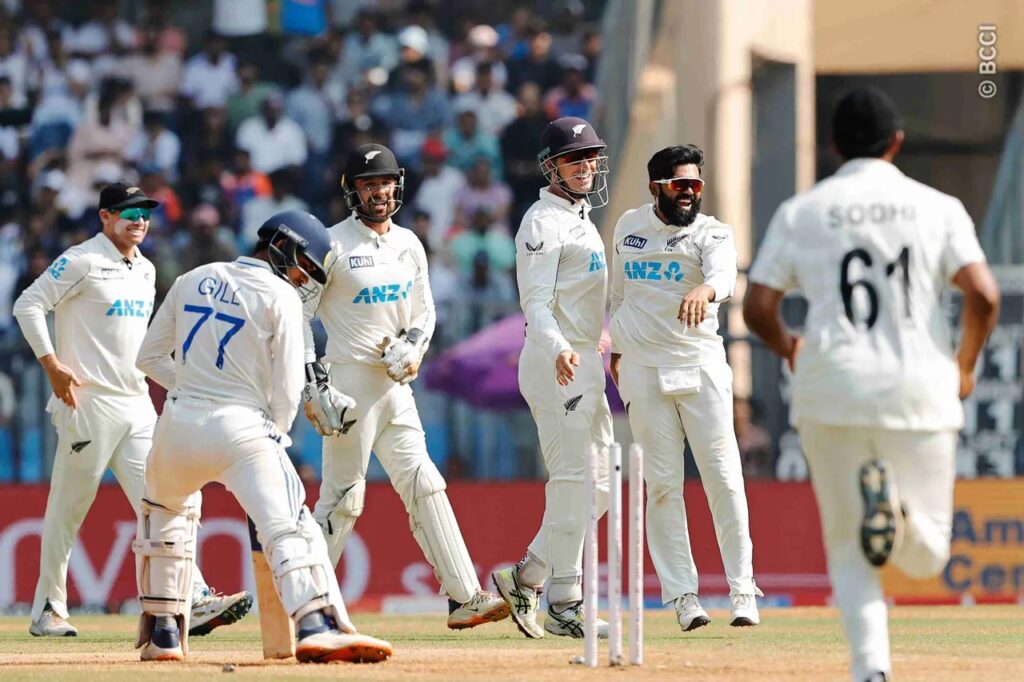
Atreyo Mukhopadhyay in Mumbai
“Is this Test cricket?” spectators at a packed Wankhede Stadium started wondering after India lost their fifth wicket in the eighth over. “Test match khelna bhul gaye sab log (these guys have forgotten how to play Test cricket),” murmured others. “Send them back to Kanga League.” These were the refrains as India crashed to their most embarrassing series defeat on home soil in history.
Ignoring the heat and humidity — this was the warmest October in several parts of the country after 1951 — the fans turned out in numbers in Mumbai. Tickets come for a premium and food and drinks in the stadium cost a bomb. Despite all that, the diehard fans of Indian cricket had shown no lack of commitment even when it came to watching the last match of a series their team had already lost.
Other than infuriating the thousands who turned up for two and-a-half days, the performance of the Indian team raised a few questions. The answers are simple. The team management and the people responsible for taking decisions made simple matters complicated. New Zealand didn’t play outlandish cricket. They were good. The Indians aided them by digging their own grave.
Blinded by rain in Bengaluru
Let’s start from the first day of cricket in this series. I was outside the M Chinnaswamy Stadium in Bengaluru, doing a live video with colleagues back in the office. It was possibly the darkest 9 am I have ever seen. It had rained heavily the last few days and Day 1 of the match had been called off. The floodlights were on at that hour and it was moist and damp all around.
I got a shocker when I heard Rohit Sharma had elected to bat. It was more like Wellington on a chilly morning and yet, our captain let the New Zealand bowlers have a free run at his own batters. To the absolute glee of the visiting side, the ball did all sorts of things and India got slammed. The total of 46 decided the match then and there. To make matters worse, India went in with three spinners.
Panic button in Pune
A message was sent to those preparing the pitch in Pune from the Indian team management. They wanted an out-and-out spinning track. They thought that this was the only way for them to make a comeback into the series. It showed that this team doesn’t learn from past blunders. It was in Pune on a rank turner that India had suffered a 333-run defeat against Australia in 2017.
New Zealand won the toss this time and India were straightaway on the back foot. The ball spun considerably from the first day. Batting became progressively difficult as the game went on and the home team batters were in distinctly more discomfort than the visitors. They had no clue to Mitchell Santner and once again, lost the match virtually in the first innings.
Among the less discussed features of that Test was how India negated their biggest strength. Jasprit Bumrah bowled 14 of the 150 overs India bowled in this Test. Akash Deep got six. Effectively, Rohit’s team played the match with three bowlers despite having five in the XI. Unbelievably, they opted for conditions where their best bowler — Bumrah — could not be used.
🚨 India have been whitewashed for the first time at home by New Zealand.
Where does this put the team in WTC Final qualification and will it affect the confidence going into Australia?@CricSubhayan and @atreyom analyze! #INDvNZ #WTC2025 #WTCFinal2025 pic.twitter.com/34VjLbQn2y
— RevSportz Global (@RevSportzGlobal) November 3, 2024
Lesson not learnt before Mumbai
It was again shocking to see media reports that the team management had requested the Mumbai Cricket Association for another turner at Wankhede. Indians can’t handle spin on such strips was well known and seen again barely four days back. Still, they opted for a track loaded in favour of spinners and surrendered meekly. Basically, they dug their own grave.
In home conditions, the Indians are far better off on normal pitches, which play good for batting on the first few days and start assisting spinners towards the end of a Test match. India had won four games against England on such tracks earlier this year. Still, they opted for this suicidal ploy and paid a heavy price. It led to the first-ever clean sweep India suffered on home soil.
More questionable calls
There were more debatable decisions. Having three fielders or more in the deep within the first 30 minutes of the second Test was one. There was no need to allow easy singles so early on Day 1. Not using Bumrah during a crucial century-plus, eighth-wicket stand between Rachin Ravindra and Tim Southee in the first Test was another. Tinkering with the batting order was again a needless call.
However, those were strategic errors during the matches. The most glaring blunders were made even before the games had started. The Indians made New Zealand feel at home by offering conditions that didn’t help their own team. One can accept the odd bad decision, not a series of them. India lost the series in the head. India’s on-field performances were a reflection of this confused state of mind.